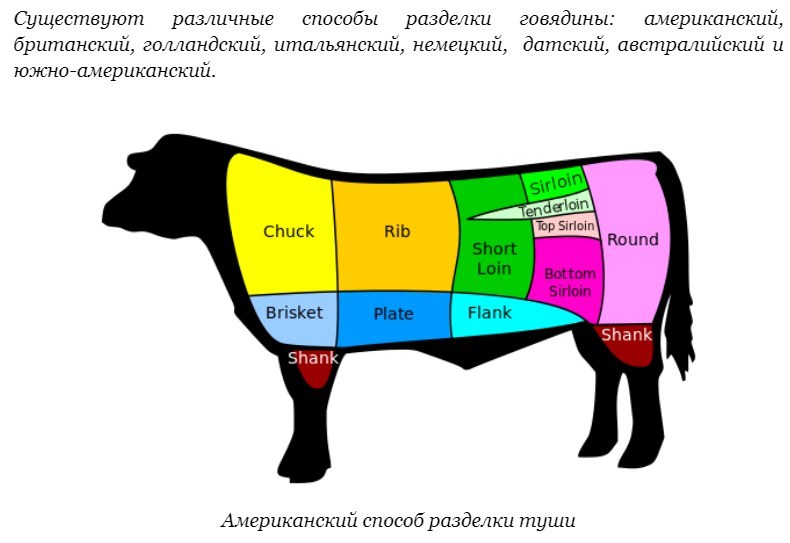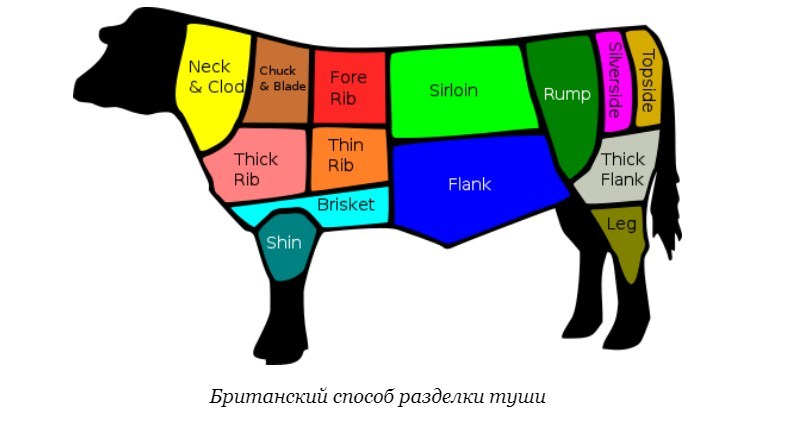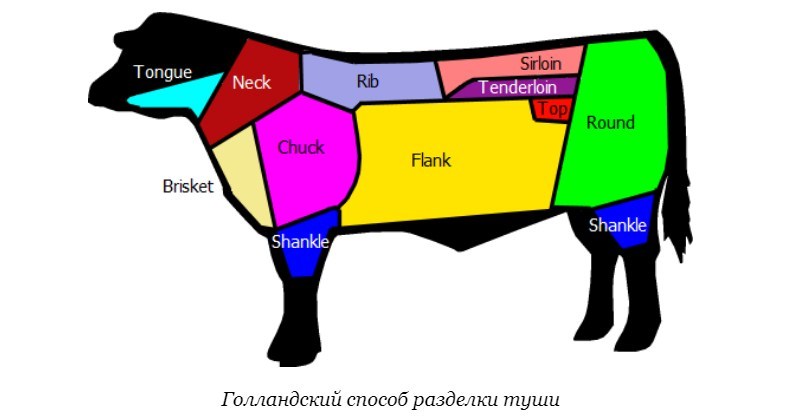To cook meat is art, to cook deliciously - real art. But it is equally important for the final result to correctly cut the meat and know which of the parts is best suited for a particular dish.
Content
- Beef cutting diagram
- What part of the mascara of beef for what to use?
- Video: profitable beef cut
- Pork cutting diagram
- The name of the parts of pork carcass when cutting
- Video: cutting pigs of pigs
- Cutting diagram of lamb carcasses: a photo with a description
- Parts of the lamb carcass and their use
- Video: lamb cutting
- How to determine which part of the carcass to choose: tips
- Video: How to choose meat?
The most popular species have long been beef, pork and lamb, and it is precisely about them that will be discussed.
Beef cutting diagram
The beef’s carcasses begin to cut it into two parts - the posterior and the front, taking as a basis the line that passes over the last rib and passes between the two vertebrae - the thirteenth and fourteenth. The ribs remain in the front.
Then both parts of the carcass are sequentially divided into several components:
- A shoulder blade, which in turn is divided into shoulder and shoulder parts
- The cervical part
- Back (this part is often called a thick edge)
- Brucking, which is a muscle tissue located above the middle part of the ribs and saturated with thin fat layers
- Brisket
- Cutting
- The back leg consisting of the internal, lateral and outer parts
- Lumbar (or thin edge)
- Pashina



What part of the mascara of beef for what to use?
The presented scheme indicates the parts of the beef carcass that the buyer can find on sale. Their names and location on the carcass of the animal will help to determine for preparing which dish this or that piece of meat is best suited.

- This sector means neck or cut. This is a meat quite saturated with tendons, but in general, its taste is quite good. Needs prolonged heat treatment, this part of the beef is better cook and stew for a long time. It is used to prepare broths and gas stations, minced meat and cutlets later, can be used to prepare goulash and junction. It is considered third -rate meat.
- For the spinal part, which is often sold with bones, there are divisions into thick and thin edges containing 4-5 ribs, and a selected intercostal pulp, passing along the spine, which is called entrecote. These are meat 1-2 varieties, it is soft, with thin fibers. It can fry, bake, extinguish. And you can cook from the costal part of the back soups, fry in the form of steaks and roast boughtyles, antrakots and chopped cutlets. Delicious from this piece you get meat on the ribs, as well as hot and goulash.
- Obwell, called yet thick fille, It is meat of a delicate structure with the content of thin fat layers. This is first -oriented meat, which can not only be stewed, but also quickly fry. Therefore, they often prepare from the wrap Tails, steaks and cutlets, Fill zrazyTwist rolls, stir up meatzi and Befstroganov, The upper edge is best suited for. Believers are also made from the outskirts, the meat is used to prepare various fillings.
- The most tender part of any meat, including beef, which is valued the highest and is always first. cuttingor just fillets. It practically in it there is no fat and vein. Files well fry and bake with a whole piece, as well as grill. Excellent chop and beef strokes with roastbifs, Good for shashlykov and Azu.
- This sector is presented kostretswhich is a soft, with good taste, first -grade meat. The most appreciated part of the bonfire is internal. Well suited for frying, extinguishing and baking, Often - for cooking soups and broths. From the inside, it is best to prepare beef strogans, in addition, use for preparation Bitches and cutlets.
- The thigh in which the middle part is distinguished, called cucumber, internal - probe And the bottom called ssek. The meat of this part belongs to the first grade, it is not oily, has thin fibers and good taste. They boil from it broth and soup, And also cook rostbif and cutlets. In addition, it baked well and extinguished.
- The second grade includes a part of the carcass called peritoneum (or Pashina), this meat is quite a rough consistency, sometimes containing a certain amount of cartilage and bones, film and fat may also be present. It is used for cooking minced meat, bites, zrace and meatballs, in rolls. When boiling, rich broth, soups and borscht is obtained.
- Regional shreds The content of the fat layer is inherent, but this part is quite tasty and is primordial. It is often prepared from it ground meat, Stew in the form gulyasha or Azu, Fry cutlets, is also used for the preparation of gas stations.
- Part called spatula, it is considered second -rate meat, since its fibers are somewhat rude, with thick veins. But in general, the meat is low -fat and is used for bifsteks, rolls, azu, goulash, chopped cutlets, as well as as part of minced meat. The meat is suitable for cooking and extinguishing.
- The structure of the brisket It is layered, with layers of fat. Refers to the first grade and has good taste. You can cook and stew, bake in the oven, use for stuffing. Good for the preparation of the first dishes and hot.
- U superior Not the best consistency, but the taste is quite good, and the gelatin added in the structure of this part adds aroma. The meat is considered third -rate and suitable for cooking supov, Gulyasha, Azu. It is better to extinguish it with large pieces, and if you fry, then over low heat.
- Well -known golyashkawhich is mainly associated with the cold. Contained in it in large quantities tendons and connective tissues, Together with the brain bone, and most importantly - gelatin and give a certain stickiness. This part of the carcass belongs to third -rate and is suitable mainly for slow cooking of the same cold men or broths. And if you separate the pulp, then it can be used to prepare cutlets, cakes and meatballs.
- Sail By their characteristics similar to Golyashka And it differs only by the location - this is part of the front leg, while the gholyshka is the back.

Video: profitable beef cut
Pork cutting diagram

The most common are four options for which pork carcass are cut:
- German cutting scheme of pork carcass: The carcass is divided into 8 parts, with purely German practicality based on the purpose of one or another part and its variety value. To the first grade include the most meat areas - horny, cutlet and lumbar parts. Second grade Go front ham, vertebrates, as well as a brisket. Third grade marked the abdominal part, and the fourth - heads, tails, ears, legs, cheeks.
- English cutting scheme pork carcass It provides for half the parts: three parts of the body - before, ass and central, Separately there is a head. They begin to cut with the fact that the carcass is chopped along the length into two parts, thus obtaining half a little machine. After that, each part is divided into six segments, also sorting them. The first variety is the shoulder blade, the second is the file part, the third is the ham, the fourth is the sidewall, the fifth is the front ham, and the sixth head is labeled.
- For the Russian scheme, as for German, the separation of carcasses into 8 parts, Each of which provides for products of a certain purpose: journal and back, scapula and brisket with nasheina. Separately, there are filled with bones, tendons and cartilage Head (with her - neck and cheeks), legs (lower part) and hooves.
- The American scheme of cutting parts of the carcass is something similar to the English, it also uses the initial division into two parts along the length of the carcass, and then into six components: a shoulder blade, back with a file part, front and rear ham, a sidewall and a head. It is also permissible in the American scheme that the occipital of the occipital part of the head as an independent.

The name of the parts of pork carcass when cutting
Parts of the carcass described here are numbered in accordance with their location in the diagram, so that, buying pork, you can always navigate and choose the right piece of meat.

- In the pig, such parts of the carcass are distinguished as cheeks and head It contains enough fat that can be boiled or salted. This part is not widely used and belongs to the fourth grade, but is still often used to make a junction, and the pork cheek can be used for rolls. The very skillful housewives stuff their heads.
- Pork ears are essentially cartilage And therefore are also defined as the fourth variety. This is a delicacy for an amateur, your ears can be welded, baked, marked and even fry. The most popular dish is the ears prepared according to Korean recipes.
- The piggy is an original shape, it can boil or bake whole. Also, the treat is not for everyone, but this piece related to the fourth grade has its own admirers, acting as an independent dish.
- Front of the ridge, or neck - This is a second -grade meat, tender and practically no fat. It is suitable for cooking in any way, From cooking and frying to extinguishing and baking. The first dishes are boiled from it, heated, suitable for barbecue.
- Korea, which is the spinal part, is a first -aimed dark meat of a homogeneous consistency, surrounded by a fat layer. It is quite elastic, but excellent cutlets or chopping. It’s good in Aza or for barbecue, as well as for the preparation of a shnitzel. In addition to frying, the Korea can be baked.
- The most valuable and delicate first meat is cuttingrelated to the lumbar. When extinguishing, baking or frying, almost any meat products come out of it, from chop and escalopes, to schnicell. They often cook from clipping hot, fried kebabs. And the broth for soup or borscht from it is rich and tender.
- HORD (or ham) It is a hip part. This meat of the first grade, it has a dense structure and at the same time quite juicy, covered with thin film and fat. In addition to the broth, it is good to cut Fry cutlets and shnitzeli, And also cook hot. This part of the carcass is used in dried form.
- Another part of the "amateur" is tailwhich is a muscle along with the tendons, the skin and fat component. The tails are fourth grade And they are suitable for Boil cooking, Saturating them.
- Front and hind legs Represent accordingly the steering wheel and the goglyashka. This is the fourth variety, since this part contains many film and tendons. Requires long -term preparation in the form cooking, baking, frying or extinguishing. It is usually used for soups, jerks, or for dishes, which is called the "Sail", popular in many kitchens.
- Shoulder blade refers to the second grade due to the presence of a layer of fat. But this does not interfere with it from it delicious minced meat, successfully extinguish hot, bake rolls or fry shnitzeli. Good borsch, the broth for which was cooked from the shoulder blade. In addition, the spatula is used in the manufacture of sausages.
- Muscles with the presence of film and fat are called infants or a prickly And belong to the third grade. The underlining is boiled, baked, fried, smoked, grilled, getting excellent first dishes, delicious goulash or hot.

Video: cutting pigs of pigs
Cutting diagram of lamb carcasses: a photo with a description

They begin to cut the lamb carcasses from cutting into two transverse parts, receiving the front and rear half a half, separated along the line passing along the rear leg and then along the pelvic bone, passing between sacral and lumbar vertebrae.
The scheme of the allocation of mascara parts is as follows:
- Front legs, or shoulder blades.
- The cervical part.
- The spinal part with the ribs, which is called the Korea.
- The costal part in which there are no fragments of Pashina is usually called the bride.
- Horny, i.e. hind legs.
Parts of the lamb carcass and their use
On which part of the mascara you bought, it depends on which dish you can cook. As a rule, a ram meat has a specific smell, and its taste must be able to open it correctly. This will help the following scheme, according to which the culinary cutting of the lamb carcass occurs.

- The most tender is the meat located in the lumbar, from it you will get barbecue and cutlets on the bone, you can fade chucks and bake in the oven. It is suitable for pilaf and just for boiling in broths.
- Most of the meat is contained in ham (this is the cut of the hip part). It is also meat for a rich menu: broken and ordinary cutlets, shnitzeli and barbecue, eastern luly-kubab dishes and real pilaf. It can bake and fry.
- In the brisket - fatty meat due to a large amount of fat layers, so it is suitable for pilaf, for stew and for the same barbecue. You can boil the brisket by preparing a gas station.
- From Pashina (such is the name of the abdominal wall) prepare a gas stimulus, used in stew and rolls, preparing pilaf. Pashin can also turn away.
- The cervical part Fatty enough, but has a special aroma. Used for cooking steaks, cutlets and schnicells. Good for soups and stewed dishes.
- The traditional lower parts of the legs of the nickname (front leg) and the goglyashka (back) are used, as a rule, for the refrigerator due to the presence of gelatinating substances, as well as broths. The meat of these parts can be stewed.
- Korean meat Fat quite fat. It suitable for cooking chips and cutlets, It is good to fry it and cook a barbecue.
- From light blades They will come out cutlets, the meat of this part is also well fried.
As for the cutting of the lambs, their carcasses are divided differently. Typically, parts are smaller when cutting, and milk lambs are most often baked in a whole. The carcass of the lamb is divided into the following parts.
- Kostrets They usually cook in one piece, extinguished or grilled. As for the bone - this is at the discretion of the hostess, it can be left, or it can be removed.
- In the back Three parts will be allocated at once: the saddle, which is the most popular, fillet, which is often offered as a cutlet, and the neck is juicy, with layers of fat, so that it can be stewed and cooked, preparing the stew or hot.
- Meat from the shoulder blade Universally, thanks to its delicate structure - you can do absolutely everything with it: cook, fry, bake. In addition, it can be bought already in a chopped form or in the form of a folded roll.
- Meat interspersing with thin layers of fat characterizes brisketwhich is used for broths or for cooking hot.
- Similar meat and in the underlying part, it is also suitable for cooking.
Video: lamb cutting
How to determine which part of the carcass to choose: tips
- We are used to calling any meat in which only the pulp and there are no bones. But experts say that cutting is the central part of the carcass Directly above the spine, on top of which a layer of fat runs.
- The neck cannot be called all the meat surrounding the head, but only pieces On the sides of the cheeks, behind them, connecting the body and head.
- Ham Only the upper rear legs, and not the entire part above the knees, can be called.
- Shoulder blade Because of its relative stiffness, it is better to lay outbut fat korean You can frySalo will give her softness and juiciness.
- Brisket Often compared with bacon due to alternating layers of meat and fat. If a smoke Such meat, you really can get a real English bacon.
- For cooking minced meat on cutlets You can take it practically any part of the carcass, except for tails, ears and heel.
- For fans of fat, to make sure that it is not from a glue near the bladder, set fire to the fat skin. If it is from the pashnaya part, the lard will be given to urea.
- When buying beef, carefully see what color the meat is. The older the animal, the darker the meat piece will be. And, by the way, stiffness depends on age. The most tender thing is pinkish calf meat, dark red, with a dark yellow shade, speaks of the venerable age of the animal and, accordingly, will be much tougher, no matter what part-fillet or scapular-it is cut out.
We advise you to read useful articles from which you will learn how to choose:







